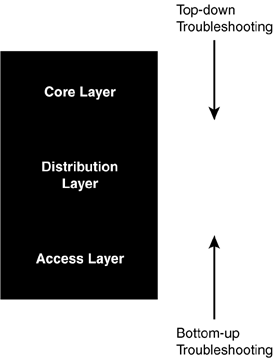The Cisco Campus Model
| For the exam, you need to be able to take the same techniques that we applied to the OSI Reference Model and apply them to the Cisco Campus Model as well. Although the layers and functions are different, you can take a divide-and-conquer approach to the three layers of the Cisco Campus model and apply the same techniques learned previously. Your bottom-up troubleshooting would start by checking connectivity problems with your users accessing the campus from the Access layer. Next you would check the Distribution layer, and then you would move up to the Core layer where a majority of users would be affected. Let's take a look at Figure A.2, which shows the Cisco Campus model and its three layers. Figure A.2. The top-down and the bottom-up approach to troubleshooting using the Cisco Campus Model. If you quickly determine that most or all of your users are affected by the problem, you would troubleshoot from the reverse direction and take a top-down troubleshooting approach. You would use this approach because the Core layer affects most of your users. The access layer would affect only localized data traffic affecting only a small percentage of users in the network. |
EAN: 2147483647
Pages: 213
